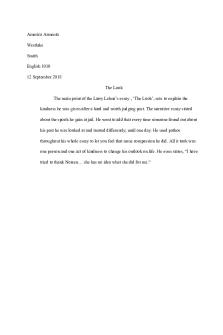Literary Analysis of Frederick Douglass\' Narrative PDF

| Title | Literary Analysis of Frederick Douglass\' Narrative |
|---|---|
| Author | Miles Alberca |
| Course | English |
| Institution | East Carolina University |
| Pages | 1 |
| File Size | 33.8 KB |
| File Type | |
| Total Downloads | 22 |
| Total Views | 149 |
Summary
Style/Literary Analysis of Frederick Douglass' Narrative...
Description
Introduction The narrative of the life written by Frederick Douglass is considered to be one of the most powerful books created by abolitionists. It makes us dive into the time of slavery, suffer together with the slaves, and feel physically and emotionally the injustice of the system of the slavery. It gets more values by the fact that this work was written by the American slave by himself. Therefore, we can find out black people’ real living conditions and their slavers’ cruelty in its true colors. Douglass was a genius writer who applied skillfully emotion imagery, figurative language, and anecdotes for presenting readers the evil of slavers. In our work we will analyze the literary devices which Frederick Douglass used in the narrative for persuading us in the slavers’ cruelty, cynicism, and meanness. Thesis: In order to show the cruelty, cynicism, and meanness of slavers Douglass appeals to emotional imagery, wide range of figurative language such as metaphors, metonymy, personification, epithets, simile, repetitions, and irony, and anecdotes. Main Body Emotion imagery The use of the emotion imagery in Frederick Douglass’s narrative allows readers to feel almost physically slavers’ cruel actions and get into Frederick’s shoes. The emotion imagery is very important for creation of true-to-life situations and images. It appeal to readers’ five senses influencing their taste, touch, sight, smell, and sound. According to Fleckenstein, Calendrillo, and Worley, there is no literature without emotions. Emotions are produced by the mental images which are “the experience of a perceptual phenomenon (visual, somatosensory, auditory, olfactory, etc.) in the absence of sensory (‘external’) stimuli (Langer, 2012, p. 178). The mental images activate the visual brain areas which cause the activation of the emotional brain areas ((Langer, 2012, p. 178). As a result, the author manages to get out a message to the readers. For example, the image of a hunger slave created by the author makes us suffer from the hunger together with Frederick. Thus, the description of the slaves as “poor creatures been nearly perishing with hunger” and feeling “the painful gnawings of hunger” which narrator experienced makes us create an exhausting starving image of slaves. (Douglass, 1845, ch.9). Then, we feel the delicious taste and smoke of the dishes and feel hunger together with Douglass “when food in abundance lay mouldering in the safe and smoke-house” (Douglass, 1845, ch.9). This painful experience underlines the cruelty and meanness of Douglass’s master. Then, the book is full of the images of the masters who owned Douglass at different times of his life. All of them implemented each other and were built in one image of a cruel, mean, cynic slaver whom believing in God did not prevent beating the slaves up to death, raping the black women, treating them as cattle, and neglecting their human features. For example, Master Thomas Auld was a good example of the mean slavers who had full house of preachers but kept one young black …...
Similar Free PDFs

Literary analysis of \'I spy\'
- 2 Pages

Literary Analysis Example
- 3 Pages

Literary Analysis (Genesis)
- 27 Pages

Literary Analysis Worksheet 1
- 2 Pages

Narrative Analysis-English 1010
- 1 Pages
Popular Institutions
- Tinajero National High School - Annex
- Politeknik Caltex Riau
- Yokohama City University
- SGT University
- University of Al-Qadisiyah
- Divine Word College of Vigan
- Techniek College Rotterdam
- Universidade de Santiago
- Universiti Teknologi MARA Cawangan Johor Kampus Pasir Gudang
- Poltekkes Kemenkes Yogyakarta
- Baguio City National High School
- Colegio san marcos
- preparatoria uno
- Centro de Bachillerato Tecnológico Industrial y de Servicios No. 107
- Dalian Maritime University
- Quang Trung Secondary School
- Colegio Tecnológico en Informática
- Corporación Regional de Educación Superior
- Grupo CEDVA
- Dar Al Uloom University
- Centro de Estudios Preuniversitarios de la Universidad Nacional de Ingeniería
- 上智大学
- Aakash International School, Nuna Majara
- San Felipe Neri Catholic School
- Kang Chiao International School - New Taipei City
- Misamis Occidental National High School
- Institución Educativa Escuela Normal Juan Ladrilleros
- Kolehiyo ng Pantukan
- Batanes State College
- Instituto Continental
- Sekolah Menengah Kejuruan Kesehatan Kaltara (Tarakan)
- Colegio de La Inmaculada Concepcion - Cebu










